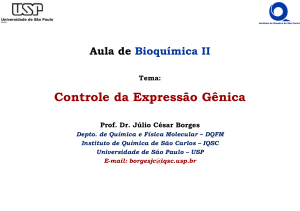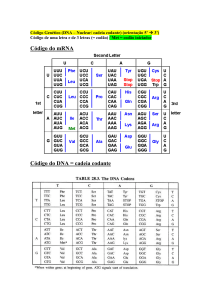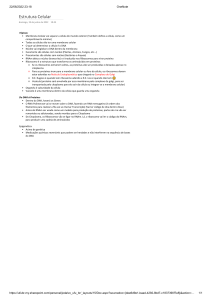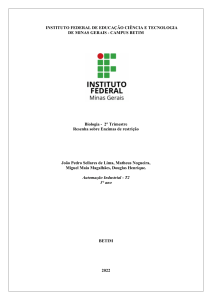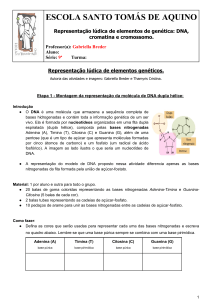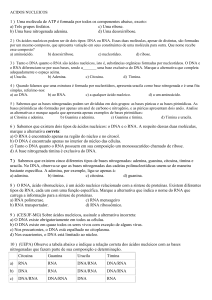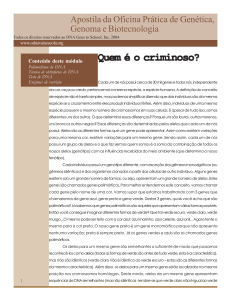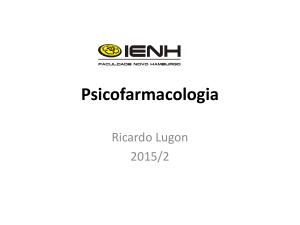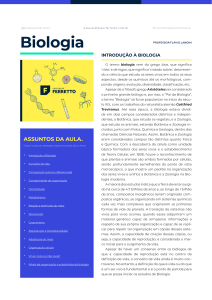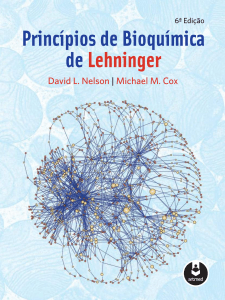Slide 1
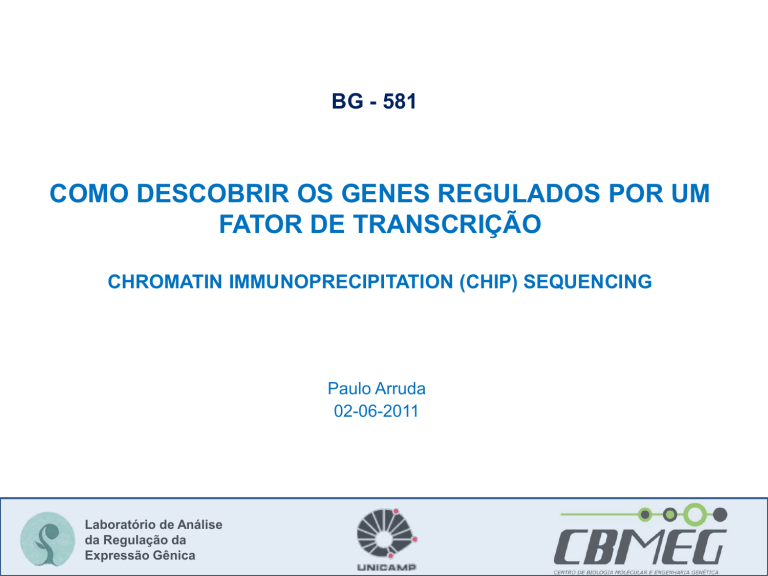
BG - 581
COMO DESCOBRIR OS GENES REGULADOS POR UM
FATOR DE TRANSCRIÇÃO
CHROMATIN IMMUNOPRECIPITATION (CHIP) SEQUENCING
Paulo Arruda
02-06-2011
Laboratório de Análise da Regulação da
Expressão Gênica
O DANA GENOMICO ESTÁ SEMPRE ASSOCIADO A PROTEÍNAS
Uma das funções desse conjunto de proteínas é manter os genes inativos
Laboratório de Análise da Regulação da
Expressão Gênica
AS PROTEINAS ASSOCIADAS AO DNA GENOMICO FORMAM
COMPLEXOS CONTENDO CO-REPRESSORES E ENZIMAS
Laboratório de Análise da Regulação da
Expressão Gênica
A ATIVAÇÃO DE UM GENE REQUER A DISSOCIAÇÃO DOS COMPLEXOS
COREPRESSORES/ENZIMAS E A LIGAÇÃO DOS FATORES DE
TRANSCRIÇÃO
Laboratório de Análise da Regulação da
Expressão Gênica
A ATIVAÇÃO DA TRANSCRIÇÃO ENVOLVE UM CONJUNTO GRANDE DE
DIFERENTES PROTEÍNAS SENDO A ESPECIFICIDADE DETERMINADA
PELOS FATORES DE TRANSCRIÇÃO
Laboratório de Análise da Regulação da
Expressão Gênica
COMPONENTES DA ORQUESTRA
Laboratório de Análise da Regulação da
Expressão Gênica
COMO SERÁ QUE MILHARES DE ORQUESTRAS JUNTAM SEUS COMPONENTES
AO MESMO TEMPO?
(A) Cooperative chromatin remodeling events (left) induced by ATP-dependent factors (purple) and histonemodifying acetyltransferase activities (red and orange) through their interactions (broken arrows) with each other and some transcriptional regulators (blue circle) that have access (thick arrow) to specific DNA sequences through gene-specific nucleosome positioning effects.
(B) Chromatin remodeling lead to nucleosome shifting relative to specific target sequences as well as histone acetylation (grey lines), which together likely allow full template accessibility to other transcription factors (blue diamond and Sp1, green hexagon) and the core machinery (right). Activators and their co-regulators can interact (thick black arrow) with multiple components of the core initiation machinery;
(C) Activated transcription (black arrow) requires the assembly of a large oligomeric initiation complex and, likely, multiple concerted signals (red arrows) from several gene regulators.
Pre-assembly model for transcription initiation. A holoenzyme (i.e., a complex containing chromatin remodeling factors, multiple co-regulators,
RNA polymerase, the core initiation machinery, and
RNAprocessing factors) is recruited via cooperative interactions with several gene regulators.
Laboratório de Análise da Regulação da
Expressão Gênica
OS NUCLEOSSOMOS REPRESENTAM O MENOR NÍVEL DO COMPLEXO
DNA/PROTEÍNA QUE ESTRUTURA A CROMATINA
Laboratório de Análise da Regulação da
Expressão Gênica
O COMPLEXO DNA/PROTEÍNA PODE SER FIXADO
Tratamento com formaldeido faz o “cross-link” das moleculas de proteinas ao DNA “congelando por exemplo os Fatores de Transcrição no seu sítio de ligação ao DNA
Cross-linking pode ser feito em:
• Celulas em suspensão
• Cultura de células em placa
• Tecidos
• Cortes histológicos
Laboratório de Análise da Regulação da
Expressão Gênica
O ISOLAMENTO DO DNA GENOMICO CARREGA AS ROTEINAS
ASSOCIADAS
Após sonicação são produzidos fragmentos de
DNA de ~ 500 nucleotídeos contendo as proteinas associadas
Anticorpos especificos contra um Fator de Transcrição pode ser utilizado para imunoprecipitar o fragmento de DNA associado a ele
O crooslink é revertido liberando os fragmentos de dana para sequenciamento
Laboratório de Análise da Regulação da
Expressão Gênica
Mardis, E.R. Nat. Methods 4 , 613-614 (2007)
OS FRAGMENTOS DE DNA IMUNOPRECIPTADOS PODEM SER
PURIFICADOS E AMPLIFICADOS POR PCR
1) AdIção de NaHCO3 libera os anti-corpos ligados ao Fator de Transcrição
2) Adição de 0.2 M NaCl a 67º por 3 horas reverte o cross-link proteína/DNA. Os fragmentos de DNA ficam livres na solução
3) É adicionado RNase A para digerir RNAs presentes na amostra
4) Os fragmentos de DNA são purificados e amplificados por PCR)
PolII Primers
Laboratório de Análise da Regulação da
Expressão Gênica
DHFR3’ UTR Primers
OS FRAGMENTOS DE DNA SÃO SEQUENCIADOS USANDO-SE
SEQUENCIADOR DE 2a GERAÇÃO E OS FRAGMENTOS SÃO MAPEADOS
NO CROMOSSOMO
Laboratório de Análise da Regulação da
Expressão Gênica
A AÇÃO DE UM FATOR DE TRANSCRIÇÃO OU OUTRA PROTEINA
REGULADORA PODE SER MAPEADA EM DIFERENTES TECIDOS
ENHANCER-ASSOCIATED
PROTEIN P300
Tissue dissection boundaries, overview of the ChIP-seq approach and summary of p300 results. Tissue dissection boundaries are indicated in a representative unstained E11.5 mouse embryo. For each sample, tissue was pooled from more than 150 embryos and ChIP-seq was performed with a p300-antibody. Reads obtained for each of the three tissues that unambiguously aligned to the referencemouse genome were used to define peaks (FDR,0.01). Amore comprehensive overview of sequencing andmapping results is provided in Supplementary Table 1. fb, forebrain; li, limb; mb, midbrain.
Laboratório de Análise da Regulação da
Expressão Gênica
FATORES DE TRANSCRIÇÃO SUPERCONSERVADOS PODEM SER
ESTUDADOS EM DIFERENTES ESPECIES
CEBPA binding in vivo in livers isolated from five vertebrate species cross-mapped to the human PCK1 gene locus. A rare ultraconserved binding event is shown surrounded by speciesspecific and partially shared binding events. On the left is the evolutionary tree of the five study species (Hsap, Homo sapiens; Mmus, Mus musculus; Cfam, Canus familiaris; Mdom,
Monodelphis domesticus; Ggal, Gallus gallus), with their approximate evolutionary distance in millions of years ago (MYA). The bottom track shows evolutionary conservation measured across 44 vertebrate species, and darker shading represents slower evolution.
Laboratório de Análise da Regulação da
Expressão Gênica
SNPs EM SÍTIOS DE LIGAÇÃO DE FATORES DE TRANSCRIÇÃO PODEM
EXPLICAR A VARIAÇÃO FENOTÍPICA ENTRE INDIVÍDUOS
DETERMINADA PELO NÍVEL DE TRANSCRIÇÃO DOS GENES
REGULADOS POR ELE
Effect of SNPs on NFkB and PolII binding. (A)
Signal tracks of a NFkB motif and a TATA box demonstrate effects of B-SNPs on TF binding, with correlations in the expected direction (that is, with correct trend). (B) Fold enrichments for cumulative SNP differences affecting BRs and for single SNPs affecting motifs, in pairwise comparisons between individuals relative to the overall frequency of binding differences for NFkB (7.5%) and PolII (25%). (C) B-SNPs affecting motifs frequently lead to binding differences with correct trend. *P < 0.001, based on randomization tests involving 10,000 permutations, that is, permutation tests. (D) BRs adjacent to differentially bound BRs are enriched for binding variation.
Laboratório de Análise da Regulação da
Expressão Gênica
TURMA BG-581 2011
DIVIRTAM-SE COM SUAS DESCOBERTAS SOBRE A
EXPRESSÃO DIFERENCIAL DOS GENES
BOA SORTE
Laboratório de Análise da Regulação da
Expressão Gênica
